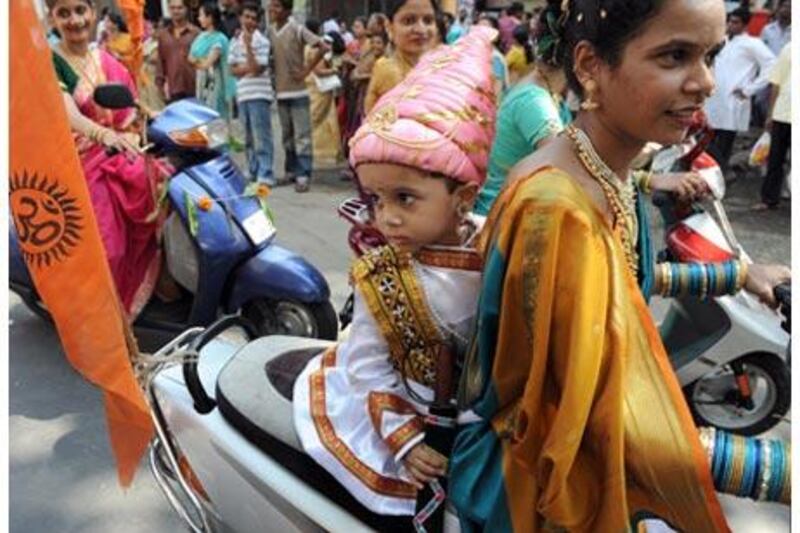The Hindus: An Alternative History
Wendy Doniger
Penguin US
Dh120
From ancient times men have dominated the world of Sanskrit scholarship. Originally those men were Brahmins; then they became Europeans, then Englishmen, and finally Indians. It is only in the past 50 years or so that women have begun to enter this esoteric field of study, and in this regard, Wendy Doniger has been a pioneer and a force to reckon with. Her new book, The Hindus: An Alternative History brings 30 years of her rigorous and innovative scholarly practice to a fitting climax - and I use the word advisedly. Doniger has studied Hinduism in its erotic, aesthetic and corporeal aspects, making her the target of envy as well as criticism from her colleagues. Her work, which includes a translation of the Kamasutra and extensive writing on Shiva, the Hindu god of cosmic destruction, who is worshipped in the form of a phallus (linga), is often seen to be titillating. She is interested in asceticism, but also in sexuality; in the spiritual, but also in the carnal.
Hindu traditions are diverse and heterodox enough to incorporate a number of parallel doctrines, theologies and belief systems, as well as an enormous repertoire of deities, symbols, rituals and concepts that contradict one another and yet coexist. Doniger's openness to the varieties of religious experience permitted under the accommodating and multifarious rubric of Hinduism has upset all manner of people, from devout Hindus, to the votaries of Hindu nationalism ("Hindutva"), from American professors to German philologists. Nearly all of them misunderstand her work, particularly her creative ways of exploring how Hindu thought connects mind, body and soul, rather than placing them in conflict with each other.
The rise of Hindu nationalism in the last two decades has made it increasingly difficult for scholars of ancient India and living Hindu traditions to do their work without fear of intimidation, harassment and censorship, both on Indian soil and among expatriate Indians, who tend to be aggressive about their often reactionary views. The very elements of Hindu public culture - argumentation, rationality and syncreticism - that Amartya Sen celebrated in his recent collection of essays, The Argumentative Indian, have been muted by the self-appointed guardians of India's intellectual, artistic and religious traditions.
In 2003, the American scholar James W Laine suffered the fury of right-wing groups in the state of Maharashtra after he published a book on the life of 17th-century Maratha king Shivaji, a potent political symbol in the religious nationalist discourse of contemporary Maharashtra. (The political party led by the anti-Muslim demagogue Bal Thackeray, who has dominated the city of Mumbai on and off for the past 20 years, is named the Shiv Sena, "Army of Shivaji".) Laine's book, Shivaji: Hindu King in Islamic India was banned, his Indian colleagues were physically attacked, his Indian publisher and bookstores carrying his work faced violent intimidation, and a major archive that he had used in the city of Pune was vandalised. That was a low point in a long struggle between the so-called "secular" left and the so-called "fundamentalist" right in India to capture texts, artworks and cultural institutions, attempting thereby to control the social and political meanings of a number of literary, aesthetic and historical symbols.
Every democracy will see such public contests over the meaning of national symbols and historical events, which often pose a challenge to the freedom of expression. In India, the conflict over Hindu culture has often taken a bitter turn, ruining many scholarly careers, and driving writers, artists and filmmakers into uncomfortable corners. Doniger has faced her share of vilification campaigns, in part for her willingness to take seriously "alternative" and "minority" interpretations of Hinduism, coming from women, lower castes and oral traditions.
Doniger's title, The Hindus, is a politic choice, pointing to an old, diverse and historically complex people (numbering over three quarters of a billion worldwide), rather than to "Hinduism", a colonial construct, or to "Hindutva", a political identity invented in the 20th century. In pre-colonial India, all manner of folks who might have practised what we understand loosely to be "religion" did not see themselves as part of any umbrella category corresponding to the English word "Hinduism". There was no single "-ism" at play until India's encounter with European missionaries and colonists in the 17th century. As Doniger writes, tongue in cheek, today we could just as well call it "the religion formerly known as Hinduism".
In a ground-breaking work some years ago, SN Balagangadhara, a professor at the University of Ghent, wrote a devastating critique of the very language we use today to describe religious phenomena in India. In his book, The Heathen in his Blindness, Balagangadhara questioned whether it is appropriate to use terms like "religion", "orthodoxy" and "Hinduism" at all. He asked whether what are essentially Christian categories may be imputed to non-Western systems of belief and practice without utterly misunderstanding their content and misrepresenting their function.
Doniger, while working with the existing terminology and translations, howsoever problematic, inadequate or inappropriate, has not shied away from the foundational texts of a long and rich textual tradition broadly defined as "Hindu": she has translated the Rig Veda, the Laws of Manu, and portions of the Mahabharata. She belongs to a generation that has turned the study of India on its head, raised in one paradigm and going on to invent another. This took both intellectual dexterity and political courage. She launched her illustrious teaching career in 1978, the same year that Edward Said published Orientalism. In her introduction she humorously describes herself as a "recovering Orientalist". Together with her colleagues at Chicago, especially in the 1990s, she has helped the entire field of Indic Studies to recover from the malady of Orientalism, and reinjected Indology with much-needed doses of history, theory, criticism, feminism and, let's face it, some actual purchase in an India increasingly transformed by globalisation.
Doniger and others effected a paradigm shift that younger scholars of South Asia take for granted. We've come a long way from Max Weber, Emile Durkheim, Marcel Mauss and Louis Dumont, who could write foundational sociological, anthropological and theoretical treatises on India, indeed, build entire sub-disciplines around the study of India, from afar. The compendious nature of The Hindus reflects the versatility, breadth, depth, complexity, and cross-disciplinary ability, not to mention the first-hand knowledge, that is now required of anyone who may venture to write about India, especially in its long pre-modernity, which takes up the bulk of this book. The so-called "post-Orientalist" turn has completely altered the rules of the game for South Asian studies.
Two aspects of Doniger's scholarship become immediately apparent in the current volume: her enormous erudition, and her sense of humour. Nearly 800 pages long, the book nevertheless is fun and easy to read, and entirely accessible to non-specialists. Fellow professors may scoff at her breezy, chatty style, and her frequent jokes, but lay audiences are sure to enjoy this playfulness. Isn't "philology" supposed to be "a love of language"?
Sometimes Doniger's wit is not meant so much to amuse as to translate difficult concepts into a familiar idiom. So the Mahabharata, the world's longest text and the more complicated of India's two epics, is about "the planned obsolescence of the moral world" - "an ancient Wikipedia". Disinterested action, action without the desire for its outcome (nishkama karma), Krishna's central message in the Bhagavad Gita, gives Arjuna, the reluctant warrior, the "moral Teflon" he needs to do battle against his relatives and teachers.
Doniger's stylistic preference for the humorous and the idiomatic can be seen as a function of her earthiness, her domesticity, almost. A sure sign of this orientation - call it "womanly" if you will - is the almost obsessive attention paid in The Hindus to the dog as a beast, a symbol, a character. Dogs signify many things, from settled urban life, to accidental grace, to the hidden hand of God, to the injustices of the caste system, to the elusive presence of dharma as the moral regulator of human life. Doniger is surely the first of the major scholars of matters Hindu to make this animal - together with the cow, horse and snake - so central to our understanding of India. Her insistence that we be attentive to animal imagery in Hindu culture is part of her view of Hinduism, broad enough to include folk practices, tribal cults, so-called "little" traditions of all kinds, which often remain firmly grounded in the domestic context and its familiar surround, binding the human and the natural worlds closely together.
At the beginning of her book, Doniger notes, "some of those old Brahmin males knew a hell of a lot of great stories". Most Hindus, in fact, most Indians of any religion, or even irreligious Indians, will find in this book many of the stories that they already know, in some version or other, from some source or other - stories of nymphs and sages, beggars and demons, elephants and horses, gods and men. Doniger manages to convey something that Roberto Calasso, too, communicates in his exquisitely crafted book, Ka: Stories of the Mind and Gods of India - that the deepest mysteries, the highest wisdoms, and the most abiding truths of Hindu civilisation have been distilled, within the multiple traditions of Hindu thought, into stories that we all can grasp, enjoy and repeat. Hinduism as philosophy has always been a function of elite culture; Hinduism as storytelling is part and parcel of popular culture.
In swimming through a veritable "sea of stories" (kathasaritsagara), Doniger remarks: "India is a country where not only the future but even the past is unpredictable.... You could easily use history to argue for almost any position in contemporary India: that Hindus have been vegetarians, and that they have not; that Hindus and Muslims have gotten along well together, and that they have not; that Hindus have objected to suttee, and that they have not; that Hindus have renounced the material world, and that they have embraced it; that Hindus have oppressed women and lower castes, and that they have fought for their equality."
A category like "Hindu" basically ends up subsuming within itself almost everything about the Indian subcontinent: violence, civilisation, law, piety, sex, texts, gender, caste, colonialism, deities, ritual, orthodoxy, cosmopolitanism, art. Doniger does not so much take an alternative path as she draws a circle around a vast totality that makes India quite genuinely a world unto itself - one that we may, with care and effort, comprehend, critique and cherish.
But this style of scholarship, which combines philology, philosophy and classics, may now be endangered. The entire infrastructure needed to sustain such humanistic work - from university departments, to specialised publishers, to libraries, to bookstores - is disappearing. In a recent article, Sheldon Pollock, a Sanskritist and long-time colleague of Doniger at Chicago, noted that as older scholars of classical Indian languages retire or pass away, there are no younger scholars to take their place. "Within two generations," Pollock predicted, "the Indian literary past - one of the most luminous contributions ever made to human civilisation - may be virtually unreadable to the people of India."
Paradoxically, it is the rise of India's economy that exacerbates the neglect of its pre-modern heritage, a sad state of affairs if there ever was one. In this regard, India seems to be going the way of China, rushing headlong into the future and forgetting it is the past that actually anchors a nation's soul. The only glimmer of hope comes from a nascent interest among many younger Indianists in traditions of political thought on the subcontinent. A systematic exploration of Indian political theory - going back at least 2,500 years, to the Buddha - would necessitate a renewed engagement with Indic pre-modernity. This year happens to be the centenary of Mahatma Gandhi's path-breaking book, Hind Swaraj (Indian Home Rule). If conferences and publications this year around this text are any indication, there is a lot of new scholarship about Indian political traditions in the works, which may be understood as Indology refashioning and retooling itself for contemporary academic and political contexts. More significantly, the boom in Gandhiana might be a sign that Indians are getting over the tired contrasts between secularism and religion, modernity and tradition, West and East that have thoroughly debilitated genuine debate.
For decades, intellectual newcomers to the Indian subcontinent had one go-to book: AL Basham's classic The Wonder That Was India, an encyclopaedic survey of Indian culture from the ancient period to the Mughal conquest first published in 1954. A half-century later, The Hindus is a worthy successor, a contemporary text that can transform our perception of Indian history, Sanskrit literature and the Hindu religious universe, all extremely important to understanding the wonder that was, and is, India.
Ananya Vajpeyi teaches at the University of Massachusetts in Boston. Her forthcoming book, Righteous Republic: The Political Foundations of Modern India, will be published by Harvard University Press.





